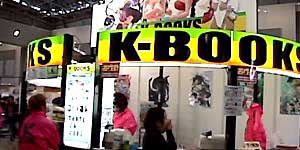by Ardith Santiago
|
I make my way downstairs right before the doors open and glimpse a sight I would never see in the states. Outside, a polite accumulation of people standing in the cold wind waits patiently for the doors to open. When the doors finally do open, no one feels inclined to rush in. Slowly, as a handful of volunteers manage the sea of bodies, the crowd inches its way forward. The feeling of restrained excitement is palatable. The volunteers remain in total control the situation, voicing orders through bullhorns to a cooperative mass. Once inside, the crowd divides, heading into the various wings of Tokyo Big Sight. The size of this event makes me realize just how ingrained the doujinshi culture is in Japan. Printing is cheap here and a big part of it must be from the sheer volume of people who want the service. There are over 20 companies that make screen tones and manga supplies. The demand for these kinds of items is enormously high for a country that is only half as populated as the United States. Fans draw comic books well into their adult live even if they have no aspirations of becoming professional or mainstream artists. A whole sub-economy, therefore, is based on the doujinshi culture.
Unlike anime and comic book conventions in the US, there are no special guests or industry panels. People are here for one thing and one thing only - to buy stuff. Special goods like clocks, calendars and even corkboards and bags are a common sight in the halls. Attendees factor impulse buys into their spending budget. Popular Circles are stationed at the sides of the halls, so that their overflow lines can spill outside through the main doors, which stay open all day, letting in the cold as well as the fans. There are so many halls and so many Circles attending that it is a necessary prerequisite to purchase the Comike Catalogue. Sold at anime and manga-themed stores long before the big event, many attendees mark out their booth path prior to going. Catalogues can still be purchased at the convention, along with bags for doujinshi goods and other Comike merchandise. And for those who cannot read Japanese, the catalogue features pictures with booth numbers in the corner that can help a wayward foreigner orient themselves in the vastness of the convention. Saturday, December 30, 2000
The second day is devoted to original doujinshi, idol-centric work, and "others," which, in this case, euphemistically refers to material with sinful appeal.
The second day also inspires me to redefine the word "crowds" in my mental dictionary. On Friday I had seen more people gathered together than I had ever imagined existed. But Saturday put Friday's hoards to shame. I could not move faster than the bodies ahead of me, the mass of us flowing along like lava from a volcano when it begins to harden into rock. Thankfully, the Comike staff has the foresight to partition walkways for traffic control. The first thought in my head as I merge with the ebbing tide of bodies is, "I am so glad that this is not the Summer Comike ... The smell would probably kill me." For the most part, the cold keeps the smell to a minimum, though I feel an empathetic pang for the lads and ladies who have decided to cosplay as scantily clad characters. As I mentioned before, bright colored badges encircle the left arms of volunteers and workers of Comike. These badges of courage are a sign of immense pride on the convention floor. I notice here, as is the case for many other conventions around the world, volunteers wear badges from previous years, as if to say, "Hey, I'm cool. I've been here since '90... '85... '76." I am wigged out to see one man proudly displaying his badges from years past on a cape he has fashioned, like feathers on a bird's back. Dozens of badges. Of course, there were occasional Con-Nazi's. Sometimes literally, cosplaying their role as crowd controllers in historic German uniforms. I move to the Outdoor Exhibition Area overlooking Tokyo Bay and find that this is the place to be to see the aforementioned cosplayers. I make my way up to the area designated for cosplay photography - an ingenious idea most likely learned from conventions past when people stopping in the halls to take pictures created horrible congestion. Here cosplayers even take pictures of other cosplayers. After a while, I learn to jump right in and ask for permission to take a picture with the phrase "Sumimasen! Shasshin totte ii desuka?" This is a far cry from the American convention practice of swarming paparazzi-style. The cosplayers smile and nod as I snap away with a digital camera. The costumes are amazing. |


